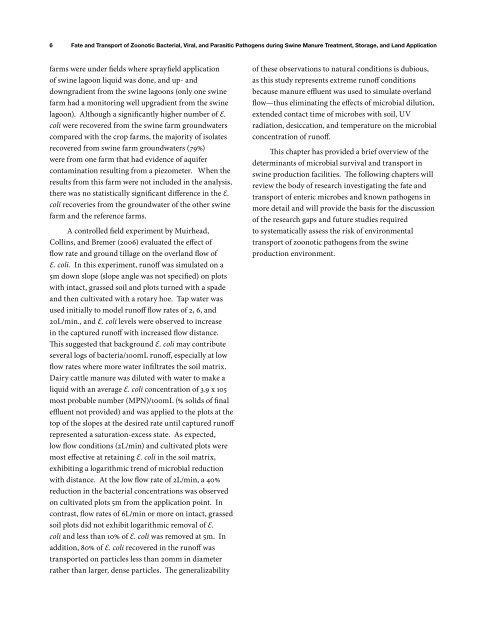Fate and Transport of Zoonotic Bacterial, Viral, and - The Pork Store ...
Fate and Transport of Zoonotic Bacterial, Viral, and - The Pork Store ...
Fate and Transport of Zoonotic Bacterial, Viral, and - The Pork Store ...
You also want an ePaper? Increase the reach of your titles
YUMPU automatically turns print PDFs into web optimized ePapers that Google loves.
6<br />
<strong>Fate</strong> <strong>and</strong> <strong>Transport</strong> <strong>of</strong> <strong>Zoonotic</strong> <strong>Bacterial</strong>, <strong>Viral</strong>, <strong>and</strong> Parasitic Pathogens during Swine Manure Treatment, Storage, <strong>and</strong> L<strong>and</strong> Application<br />
farms were under fields where sprayfield application<br />
<strong>of</strong> swine lagoon liquid was done, <strong>and</strong> up- <strong>and</strong><br />
downgradient from the swine lagoons (only one swine<br />
farm had a monitoring well upgradient from the swine<br />
lagoon). Although a significantly higher number <strong>of</strong> E.<br />
coli were recovered from the swine farm groundwaters<br />
compared with the crop farms, the majority <strong>of</strong> isolates<br />
recovered from swine farm groundwaters (79%)<br />
were from one farm that had evidence <strong>of</strong> aquifer<br />
contamination resulting from a piezometer. When the<br />
results from this farm were not included in the analysis,<br />
there was no statistically significant difference in the E.<br />
coli recoveries from the groundwater <strong>of</strong> the other swine<br />
farm <strong>and</strong> the reference farms.<br />
A controlled field experiment by Muirhead,<br />
Collins, <strong>and</strong> Bremer (2006) evaluated the effect <strong>of</strong><br />
flow rate <strong>and</strong> ground tillage on the overl<strong>and</strong> flow <strong>of</strong><br />
E. coli. In this experiment, run<strong>of</strong>f was simulated on a<br />
5m down slope (slope angle was not specified) on plots<br />
with intact, grassed soil <strong>and</strong> plots turned with a spade<br />
<strong>and</strong> then cultivated with a rotary hoe. Tap water was<br />
used initially to model run<strong>of</strong>f flow rates <strong>of</strong> 2, 6, <strong>and</strong><br />
20L/min., <strong>and</strong> E. coli levels were observed to increase<br />
in the captured run<strong>of</strong>f with increased flow distance.<br />
This suggested that background E. coli may contribute<br />
several logs <strong>of</strong> bacteria/100mL run<strong>of</strong>f, especially at low<br />
flow rates where more water infiltrates the soil matrix.<br />
Dairy cattle manure was diluted with water to make a<br />
liquid with an average E. coli concentration <strong>of</strong> 3.9 x 105<br />
most probable number (MPN)/100mL (% solids <strong>of</strong> final<br />
effluent not provided) <strong>and</strong> was applied to the plots at the<br />
top <strong>of</strong> the slopes at the desired rate until captured run<strong>of</strong>f<br />
represented a saturation-excess state. As expected,<br />
low flow conditions (2L/min) <strong>and</strong> cultivated plots were<br />
most effective at retaining E. coli in the soil matrix,<br />
exhibiting a logarithmic trend <strong>of</strong> microbial reduction<br />
with distance. At the low flow rate <strong>of</strong> 2L/min, a 40%<br />
reduction in the bacterial concentrations was observed<br />
on cultivated plots 5m from the application point. In<br />
contrast, flow rates <strong>of</strong> 6L/min or more on intact, grassed<br />
soil plots did not exhibit logarithmic removal <strong>of</strong> E.<br />
coli <strong>and</strong> less than 10% <strong>of</strong> E. coli was removed at 5m. In<br />
addition, 80% <strong>of</strong> E. coli recovered in the run<strong>of</strong>f was<br />
transported on particles less than 20mm in diameter<br />
rather than larger, dense particles. <strong>The</strong> generalizability<br />
<strong>of</strong> these observations to natural conditions is dubious,<br />
as this study represents extreme run<strong>of</strong>f conditions<br />
because manure effluent was used to simulate overl<strong>and</strong><br />
flow—thus eliminating the effects <strong>of</strong> microbial dilution,<br />
extended contact time <strong>of</strong> microbes with soil, UV<br />
radiation, desiccation, <strong>and</strong> temperature on the microbial<br />
concentration <strong>of</strong> run<strong>of</strong>f.<br />
This chapter has provided a brief overview <strong>of</strong> the<br />
determinants <strong>of</strong> microbial survival <strong>and</strong> transport in<br />
swine production facilities. <strong>The</strong> following chapters will<br />
review the body <strong>of</strong> research investigating the fate <strong>and</strong><br />
transport <strong>of</strong> enteric microbes <strong>and</strong> known pathogens in<br />
more detail <strong>and</strong> will provide the basis for the discussion<br />
<strong>of</strong> the research gaps <strong>and</strong> future studies required<br />
to systematically assess the risk <strong>of</strong> environmental<br />
transport <strong>of</strong> zoonotic pathogens from the swine<br />
production environment.


